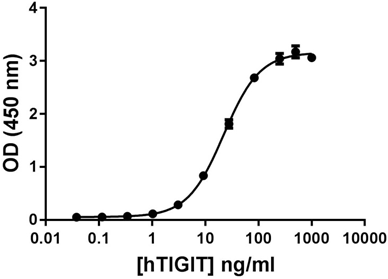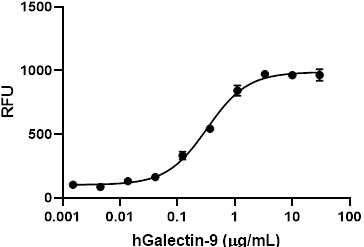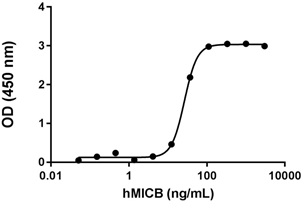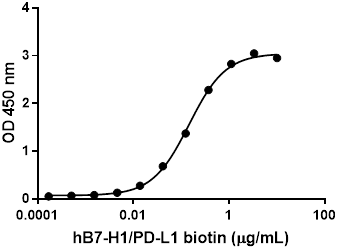- Regulatory Status
- RUO
- Other Names
- Hepatitis A virus cellular receptor 2, HAVCR2, T cell immunoglobulin and mucin domain containing protein 3, CD366, Tim, Tim-3, Tim 3
- Ave. Rating
- Submit a Review
- Product Citations
- publications

-

Recombinant human TIM-3 binds immobilized recombinant human Galectin-9 with EC50 of 0.15 - 0.6 µg/mL in a functional ELISA.
| Cat # | Size | Price | Quantity Check Availability | Save | ||
|---|---|---|---|---|---|---|
| 759902 | 10 µg | $89 | ||||
| 759904 | 25 µg | $171 | ||||
TIM-3 (T cell immunoglobulin and mucin domain-3), also known as Hepatitis A virus cellular receptor 2 (HAVCR2), is a transmembrane glycoprotein implicated in modulating innate and adaptive immune responses. TIM-3 was first discovered as a molecule expressed on IFN-γ producing CD4+T helper type 1 (Th1) and on CD8+ T cytotoxic type 1 (Tc1) cells. TIM-3 is now shown to be also expressed in Th17 cells, mast cells, macrophages, dendritic cells, monocytes, NK and NKT cells. TIM-3 negatively regulates Th1 T cell responses, but may also affect Th2-driven allergic diseases by indirectly modulating the balance between Th1 and Th2 type responses. Several genetic studies on TIM-3 polymorphisms suggest that TIM-3 is involved in susceptibility to Th2-driven allergic diseases. TIM-3 also plays a protective role in Rheumatoid arthritis. TIM-3 binding to Galectin-9 induces a range of immunosuppressive functions including Th1 cell death and a consequent decline in IFN- γ production. TIM-3 and Galectin-9 interaction leads to the enhancement of immune tolerance and the inhibition of anti-tumor immunity. Dysregulation of the TIM-3 and Galectin-9 pathway could underlie chronic autoimmune disease states, such as multiple sclerosis (MS) and TIM-3 may represent a novel target for the treatment of systemic lupus erythematosus (SLE). Cells expressing Tim-3 are present at high levels in the CNS of animals at the onset of experimental autoimmune encephalomyelitis (EAE). Tim-3 has also been shown to exist as a soluble protein.
Product DetailsProduct Details
- Source
- Human TIM-3, amino acids Ser22-Arg200 (Accession# Q8TDQ0) with human IgG1 Fc tag at the C-terminus, was expressed in 293E cells.
- Molecular Mass
- The 418 amino acid recombinant protein has a predicted molecular mass of approximately 46.7 kD. The DTT-reduced protein migrates at approximately 65 kD and non-reduced proteins migrate at approximately 120 kD by SDS-PAGE. The predicted N-terminal amino acid is Ser.
- Purity
- >95% as determined by Coomassie stained SDS-PAGE.
- Formulation
- 0.22 µm filtered protein solution is in PBS, pH 7.2.
- Endotoxin Level
- Less than 0.1 EU per µg of protein as determined by the LAL method.
- Concentration
- 10 and 25 µg sizes are bottled at 100 µg/mL.
- Storage & Handling
- Unopened vial can be stored between 2°C and 8°C for up to 2 weeks, at -20°C for up to six months, or at -70°C or colder until the expiration date. For maximum results, quick spin vial prior to opening. The protein can be aliquoted and stored at -20°C or colder. Stock solutions can also be prepared at 50 - 100 µg/mL in appropriate sterile buffer, carrier protein such as 0.2 - 1% BSA or HSA can be added when preparing the stock solution. Aliquots can be stored between 2°C and 8°C for up to one week and stored at -20°C or colder for up to 3 months. Avoid repeated freeze/thaw cycles.
- Activity
- EC50 = 0.15 - 0.6 µg/mL as measured by its ability to bind immobilized Galectin-9 in a functional ELISA.
- Recommended Usage
-
Bioassay
- Application Notes
-
BioLegend carrier-free recombinant proteins provided in liquid format are shipped on blue-ice. Our comparison testing data indicates that when handled and stored as recommended, the liquid format has equal or better stability and shelf-life compared to commercially available lyophilized proteins after reconstitution. Our liquid proteins are verified in-house to maintain activity after shipping on blue ice and are backed by our 100% satisfaction guarantee. If you have any concerns, contact us at tech@biolegend.com.
Antigen Details
- Structure
- Transmembrane protein containing immunoglobulin domain and mucin-like domain. It can exist as a soluble form lacking mucin and transmembrane domains.
- Distribution
-
Th1, Tc1, Th17, mast cells, macrophages, dendritic cells, monocytes, NK, and NKT cells.
- Function
- Modulation of innate and adaptive immune responses.
- Ligand/Receptor
- Galectin-9.
- Bioactivity
- Measured by its ability to bind immobilized Galectin-9 in a functional ELISA.
- Biology Area
- Immunology, Inhibitory Molecules
- Molecular Family
- CD Molecules, Immune Checkpoint Receptors, Soluble Receptors
- Antigen References
-
1. Anderson AC, et al. 2007. Science. 318:1141-3.
2. Koguchi K, et al. 2006. J. Exp. Med. 203:1413-8.
3. Khademi M, et al. 2004. J. Immun. 172:7169-76.
4. Zhu C, et al. 2005. Nat. Immunol. 6:1245-52.
5. Sabatos CA, et al. 2003. Nat. Immunol. 4:1102-10.
6. Sánchez-Fueyo A, et al. 2003. Nat. Immunol. 4:1093-1101.
7. Monney L, et al. 2002. Nature. 415:536-41.
8. Rodriguez-Manzanet R, et al. 2009. Immunol. Rev. 229(1):259. - Gene ID
- 84868 View all products for this Gene ID
- UniProt
- View information about TIM-3 on UniProt.org
Related Pages & Pathways
Pages
Related FAQs
- Why choose BioLegend recombinant proteins?
-
• Each lot of product is quality-tested for bioactivity as indicated on the data sheet.
• Greater than 95% Purity or higher, tested on every lot of product.
• 100% Satisfaction Guarantee for quality performance, stability, and consistency.
• Ready-to-use liquid format saves time and reduces challenges associated with reconstitution.
• Bulk and customization available. Contact us.
• Learn more about our Recombinant Proteins. - How does the activity of your recombinant proteins compare to competitors?
-
We quality control each and every lot of recombinant protein. Not only do we check its bioactivity, but we also compare it against other commercially available recombinant proteins. We make sure each recombinant protein’s activity is at least as good as or better than the competition’s. In order to provide you with the best possible product, we ensure that our testing process is rigorous and thorough. If you’re curious and eager to make the switch to BioLegend recombinants, contact your sales representative today!
- What is the specific activity or ED50 of my recombinant protein?
-
The specific activity range of the protein is indicated on the product datasheets. Because the exact activity values on a per unit basis can largely fluctuate depending on a number of factors, including the nature of the assay, cell density, age of cells/passage number, culture media used, and end user technique, the specific activity is best defined as a range and we guarantee the specific activity of all our lots will be within the range indicated on the datasheet. Please note this only applies to recombinants labeled for use in bioassays. ELISA standard recombinant proteins are not recommended for bioassay usage as they are not tested for these applications.
- Have your recombinants been tested for stability?
-
Our testing shows that the recombinant proteins are able to withstand room temperature for a week without losing activity. In addition the recombinant proteins were also found to withstand four cycles of freeze and thaw without losing activity.
- Does specific activity of a recombinant protein vary between lots?
-
Specific activity will vary for each lot and for the type of experiment that is done to validate it, but all passed lots will have activity within the established ED50 range for the product and we guarantee that our products will have lot-to-lot consistency. Please conduct an experiment-specific validation to find the optimal ED50 for your system.
- How do you convert activity as an ED50 in ng/ml to a specific activity in Units/mg?
-
Use formula Specific activity (Units/mg) = 10^6/ ED50 (ng/mL)
 Login/Register
Login/Register 












Follow Us